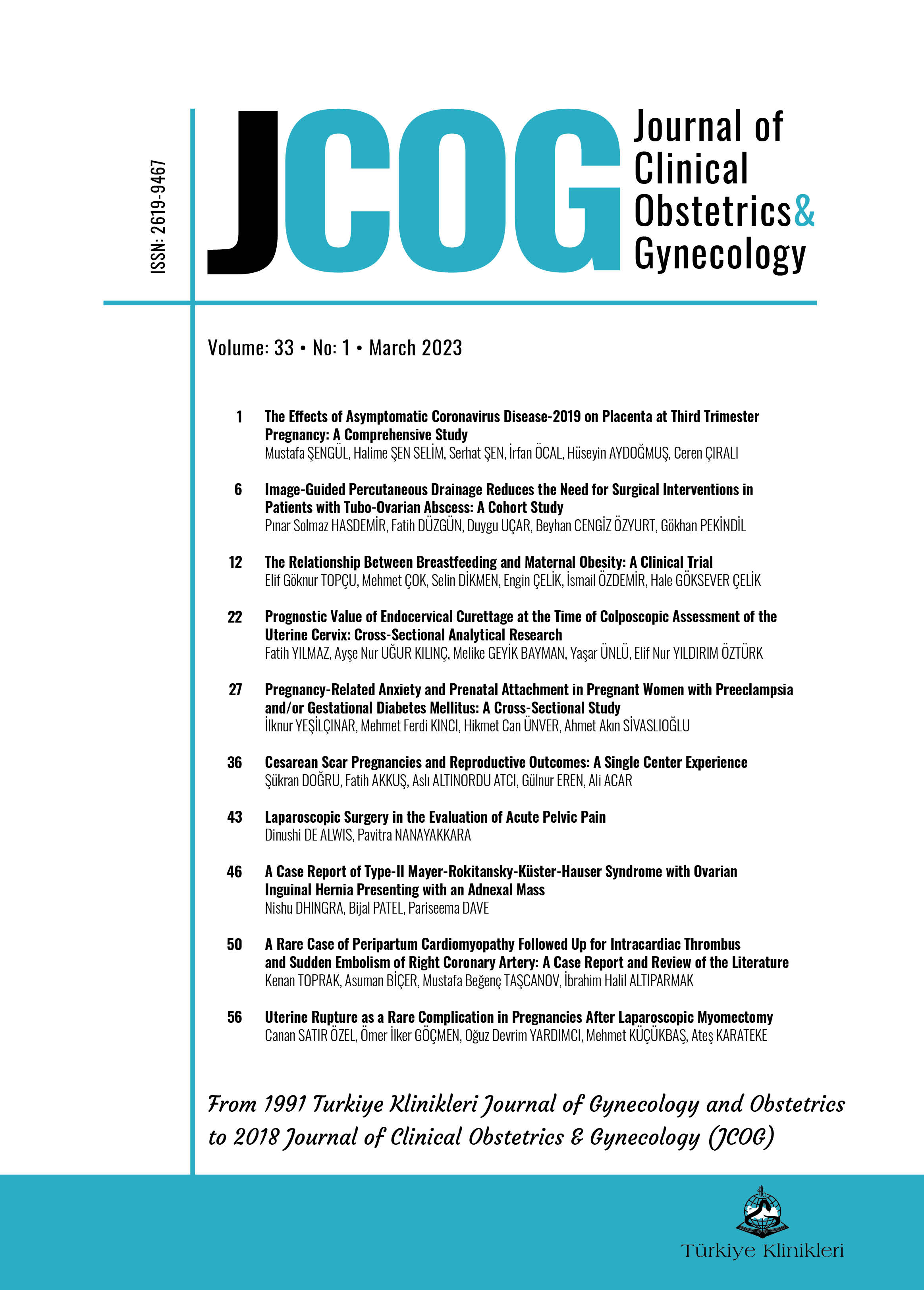Open Access
Peer Reviewed
CASE REPORTS
1516 Viewed1297 Downloaded
A Case Report of Type-II Mayer-Rokitansky-Küster-Hauser Syndrome with Ovarian Inguinal Hernia Presenting with an Adnexal Mass
Received: 26 May 2022 | Received in revised form: 01 Sep 2022
Accepted: 09 Sep 2022 | Available online: 14 Sep 2022
JCOG. 2023;33(1):46-9
DOI: 10.5336/jcog.2022-91522
Article Language: EN
Article Language: EN
Copyright Ⓒ 2025 by Türkiye Klinikleri. This is an open access article under the CC BY-NC-ND license (http://creativecommons.org/licenses/by-nc-nd/4.0/)
ABSTRACT
Mayer-Rokitansky-Küster-Hauser (MRKH) syndrome is a rare congenital disorder of the genitourinary tract seen in pediatric females. It is of 2 types. Type I has mullerian anomalies while Type II has associated anomalies. It may be associated with an inguinal hernia. The contents of the hernial sac are mostly the omentum or small intestine. Rarely, unusual contents like ovary and fallopian tubes may also be found in the hernia. The association of MRKH syndrome with ovarian hernia has been reported in a few cases in the literature. Our case is a similar rare case of a pediatric female of MRKH syndrome Type II with an inguinal hernia having an ovary as its content who presented with an adnexal mass.
Mayer-Rokitansky-Küster-Hauser (MRKH) syndrome is a rare congenital disorder of the genitourinary tract seen in pediatric females. It is of 2 types. Type I has mullerian anomalies while Type II has associated anomalies. It may be associated with an inguinal hernia. The contents of the hernial sac are mostly the omentum or small intestine. Rarely, unusual contents like ovary and fallopian tubes may also be found in the hernia. The association of MRKH syndrome with ovarian hernia has been reported in a few cases in the literature. Our case is a similar rare case of a pediatric female of MRKH syndrome Type II with an inguinal hernia having an ovary as its content who presented with an adnexal mass.
REFERENCES:
- Herlin M, Bjørn AM, Rasmussen M, Trolle B, Petersen MB. Prevalence and patient characteristics of Mayer-Rokitansky-Küster-Hauser syndrome: a nationwide registry-based study. Hum Reprod. 2016;31(10):2384-90. [Crossref] [PubMed]
- Pittock ST, Babovic-Vuksanovic D, Lteif A. Mayer-Rokitansky-Küster-Hauser anomaly and its associated malformations. Am J Med Genet A. 2005;135(3):314-6. [Crossref] [PubMed]
- Wantz GE. Abdominal wall hernias. In: Schwartz SI, Shires GT, Spencer FC, Daly JM, Fischer JE, Galloway AC, eds. Principles of Surgery. 6th ed. New York: McGraw Hill, Health Professions Division; 1994. p.1517-36.
- Gurer A, Ozdogan M, Ozlem N, Yildirim A, Kulacoglu H, Aydin R. Uncommon content in groin hernia sac. Hernia. 2006;10(2):152-5. [Crossref] [PubMed]
- Prodromidou A, Machairas N, Garoufalia Z, Kostakis ID, Kyriakidis AV, Spartalis E, et al. Ovarian inguinal hernia. Ann R Coll Surg Engl. 2020;102(2):75-83. [Crossref] [PubMed] [PMC]
- Chan D, Kwon JK, Lagomarsino EM, Veltkamp JG, Yang MS, Pfeifer CM. Canal of Nuck hernias. Acta Radiol Open. 2019;8(12):2058460119889867. [Crossref] [PubMed] [PMC]
- Kapur P, Caty MG, Glick PL. Pediatric hernias and hydroceles. Pediatr Clin North Am. 1998;45(4):773-89. [Crossref] [PubMed]
- Okada T, Sasaki S, Honda S, Miyagi H, Minato M, Todo S. Irreducible indirect inguinal hernia containing uterus, ovaries, and Fallopian tubes. Hernia. 2012;16(4):471-3. [Crossref] [PubMed]
- Thomson GR. Complete congenital absence of the vagina associated with bilateral herniae of uterus, tubes, and ovaries. Br J Surg. 1948;36(141):99. [Crossref] [PubMed]
- Fowler CL. Sliding indirect hernia containing both ovaries. J Pediatr Surg. 2005;40(9):e13-4. [Crossref] [PubMed]
MENU
POPULAR ARTICLES
MOST DOWNLOADED ARTICLES





This journal is licensed under a Creative Commons Attribution-NonCommercial-NoDerivatives 4.0 International License.










